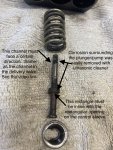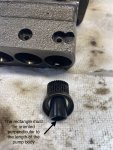“It takes half your life before you discover life is a do-it-yourself project” a quote by Napoleon Hill.
No offense intended, but why are so many fearful of taking a 750D injection pump apart? It’s not rocket science; understand your limitations. You need to be careful, meticulous, take photos, take measurements, pay attention and be methodical. Do your research, have schematics available, even watch youtube. Understand what each component does. And have a good ultrasonic cleaner. Note, I am not talking about calibration…just taking it apart, cleaning it, installing new parts, freeing up seized pumps and putting it back together. Calibration is for the pros.
Many insist only the pros can work on a pump. But that’s not an option for some. Growing up, I watched dad fix everything…we couldn’t afford to let the pros handle it. That was obviously passed down to me. The pros didn’t fix our microwave, refrigerator, ice maker, A/C, wiring, washing machine, cars…even a Dodge Intrepid internal water pump. Now, I see my 22 year old son doing the same. It is very rewarding seeing him take on these challenges and I will encourage him every time. His skillset keeps growing. America needs people like this.
Besides, it didn’t make sense to take my pump to the shop. The cost of having them rebuild and calibrate it would be the same $850 if my pump was untouched or disassembled and clean in ziplock baggies. Minimal risk…$850 reward.
Let me know if you want to know how I got my injection pump working. If enough are interested, I’ll put a detailed post together.
No offense intended, but why are so many fearful of taking a 750D injection pump apart? It’s not rocket science; understand your limitations. You need to be careful, meticulous, take photos, take measurements, pay attention and be methodical. Do your research, have schematics available, even watch youtube. Understand what each component does. And have a good ultrasonic cleaner. Note, I am not talking about calibration…just taking it apart, cleaning it, installing new parts, freeing up seized pumps and putting it back together. Calibration is for the pros.
Many insist only the pros can work on a pump. But that’s not an option for some. Growing up, I watched dad fix everything…we couldn’t afford to let the pros handle it. That was obviously passed down to me. The pros didn’t fix our microwave, refrigerator, ice maker, A/C, wiring, washing machine, cars…even a Dodge Intrepid internal water pump. Now, I see my 22 year old son doing the same. It is very rewarding seeing him take on these challenges and I will encourage him every time. His skillset keeps growing. America needs people like this.
Besides, it didn’t make sense to take my pump to the shop. The cost of having them rebuild and calibrate it would be the same $850 if my pump was untouched or disassembled and clean in ziplock baggies. Minimal risk…$850 reward.
Let me know if you want to know how I got my injection pump working. If enough are interested, I’ll put a detailed post together.



